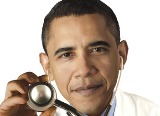 Long-awaited federal rules for health insurance plans came out Tuesday, and they make clear that insurance plans that people can buy on the open market next year will look a lot like some of the most popular plans on offer now – with a few big differences.
Long-awaited federal rules for health insurance plans came out Tuesday, and they make clear that insurance plans that people can buy on the open market next year will look a lot like some of the most popular plans on offer now – with a few big differences.
As the 2010 health reform law requires, insurers will no longer be able to dump patients who are starting to cost too much, they won’t be able to charge women more than men, they have to cover anyone who can pay and they’ll have to pay for maternity care, eye exams for kids and for mental health services.
“Insurers will not be able to charge someone more just because she is sick or because she used to be sick,” Health and Human Services Secretary Kathleen Sebelius told reporters on a conference call.
The new rules from the Health and Human Services Department cover the new state exchanges, where people will be able to buy health insurance starting in 2014.
The rules lay out how much extra insurers can charge to cover certain groups of people, like smokers and people who are older. They also say when states outline so-called essential health benefits – the minimums of what health insurers should cover – they should use the best existing plans as a guideline. HHS also issued some guidelines for employers and insurers who want to offer wellness programs, which encourage people to keep themselves healthy.
The first batch of new rules have long-expected provisions forbidding insurers to discriminate against patients who already have diseases such as cancer, asthma or heart disease. “Today, as many as 129 million-or one in two-non-elderly Americans have some type of pre-existing health condition, ranging from life-threatening illnesses like cancer to chronic conditions like diabetes, asthma, or heart disease,” HHS said in a statement.
“In most states, these consumers can be denied individual health insurance coverage or have benefits for medical conditions excluded by insurance companies. In addition, individuals and small employers often find that they have few protections against exorbitant premiums increases.”
HHS stuck with a proposal that allows insurers to charge the oldest patients three times as much as they charge a 21-year-old. And the rates can go up a little bit with every birthday. But smokers can be charged premiums that are five times higher under the new rules.
“Under the law, states can choose to enact stronger consumer protections than these minimum standards. In addition, starting in 2017, states have the option of allowing large employers to purchase coverage through the Exchanges,” HHS adds.
The health insurance exchanges are meant to be the main place that adults under 65 can buy health insurance if they don’t get covered through an employer. The 2010 Affordable Care Act is meant to improve coverage and lower costs by getting millions more Americans health insurance so they get medical care earlier, before before easy-to-treat conditions like high blood pressure can cause expensive strokes or heart attacks.
Right now, about 48 million Americans go without health insurance, according to the Census Bureau. That’s more than 15 percent of the population. About 55 percent of Americans are covered through an employer; 31 percent have a public insurance plan such as Medicare or Medicaid, and 10 percent buy their own health insurance.
The Congressional Budget Office predicts that 23 million people who don’t have health insurance now will get it on one of the exchanges. More than 18 million of them will qualify for a federal subsidy averaging $6,000 a year per person. People earning up to four times the federal poverty level can get a subsidy: that’s an income of $92,000 a year for a family of four.
The rules on so-called essential health benefits -specific services that insurers have to offer and conditions they must cover — include 10 areas: Ambulatory patient services, emergency services, hospitalization, maternity and newborn care, mental health and substance use disorder services, including behavioral health treatment, prescription drugs, rehabilitative services and devices, laboratory services, preventive and wellness services and chronic disease management and pediatric services, including oral and vision care.
“The proposed rule defines essential health benefits based on a state-specific benchmark plan, including the largest small group health plan in the state,” HHS says. These can be the largest plan, for instance, or the largest commercial health maintenance organization in a state.
For instance, if the state’s chosen benchmark plan pays for just one drug for a certain condition, so may all the plans offered on the exchange. If that benchmark plan pays for three different drugs, so will all the plans.
And HHS also set how much each level of plan – platinum, gold, silver and bronze – may require patients to pay out of pocket. Beginning in 2014, so-called bronze plans can ask patients to pay 40 percent of costs; 30 percent for a silver, 20 percent for a gold; the top-level platinum plans must pay 90 percent of patient costs. The platinum level plans may charge higher premiums, while the bronze plans will be the cheapest in terms of monthly premiums.
Finally, the rules encourage wellness plans. “Programs must be reasonably designed to promote health or prevent disease,” HHS says. “Programs must have a reasonable chance of improving health or preventing disease and not be overly burdensome for individuals.” The plans can reward patients who lower their cholesterol, for instance, by cutting premiums.
But the rules do not specify the types of wellness programs employers can offer.
States were originally supposed to say whether they would design their own insurance exchanges by last Friday, or if they will let the federal government do it, but HHS has extended the deadlines. States now can declare what they intend to do by December 14.
So-called open enrollment starts in October 2013, and plans offered on the exchanges should begin providing coverage in Jan. 1, 2014. But the rules have been so late in coming out, and the states have delayed their decisions for so long, that some critics say they doubt the federal government or state states wil be ready on time. HHS’s Gary Cohen denies this. “Absolutely, we will be ready. There will be an exchange in every state open for business on October 1 of next year,” he said.
Source: VITALS – NBC NEWS
{Matzav.com Newscenter}











